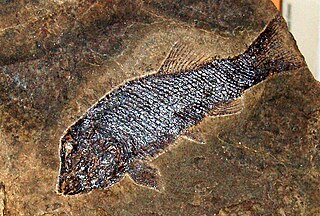Parechelus is an extinct genus of prehistoric bony fish that lived during the Ypresian. The genus was circumscribed by Edgard Casier in 1967 for his description of P. parechelus.
Salminops is an extinct genus of prehistoric bony fish that lived during the Cenomanian known from USA and Portugal.
Enischorhynchus is an extinct genus of prehistoric bony fish that lived during the Turonian of southern Texas.
Bobbichthys is an extinct genus of marine ray-finned fish that lived in what is now Chile during the Oxfordian stage of the Late Jurassic epoch. It was a member of the Varasichthyidae, a family of potentially crossognathiform fish.
Atacamichthys is an extinct genus of marine ray-finned fish. It contains one species, Atacamichthys greeni, which lived in what is now Chile during the Oxfordian stage of the Late Jurassic epoch. Atacamichthys is the only member of the family Atacamichthyidae.

Varasichthys is an extinct genus of ray-finned fish that lived during the Oxfordian stage of the Late Jurassic epoch. It contains one species, Varasichthys ariasi, fossils of which have been found in the Domeyko Range of Antofagasta Region, northern Chile. It has been placed in the family Varasichthyidae together with the genera Bobbichthys, Domeykos, Luisichthys and Protoclupea.
Antofagastaichthys is an extinct genus of ray-finned fish that lived in what is now Chile during the Oxfordian stage of the Late Jurassic epoch. It contains one species, A. mandibularis, which is known from several fragmentary specimens discovered in the El Profeta Formation of Antofagasta Province.
Chongichthys is an extinct genus of marine ray-finned fish that lived during the Oxfordian stage of the Late Jurassic epoch. It contains one species, C. dentatus from the Quebrada El Profeta of Chile. It is named after Chilean geologist Guillermo Chong.
Oligopleurus is an extinct genus of prehistoric bony fish that lived during the Kimmeridgian stage of the Late Jurassic epoch.
Agecephalichthys is an extinct genus of prehistoric freshwater "palaeonisciform" ray-finned fish that lived during the Anisian age. It contains a single species, A. granulatus from the Hawkesbury Sandstone in what is now New South Wales, Australia.
Inichthys is an extinct genus of prehistoric marine bony fish that lived during the Lopingian epoch. Fossils were recovered in the Kuznetsk Basin, European Russia.
Brachypareion is an extinct genus of prehistoric marine ray-finned fish that lived during the Pennsylvanian epoch. It contains a single species, B. insperatum, known from the Saur Mountains of Kazakhstan. It is placed in the paraphyletic group Palaeonisciformes.

Leptolepides is an extinct genus of prehistoric ray-finned fish that lived during the early Tithonian stage of the Late Jurassic epoch.
Elpistoichthys is an extinct genus of prehistoric bony fish that lived during the Carnian stage of the Late Triassic epoch.

Aetheodontus is an extinct genus of prehistoric marine bony fish that lived during the early Ladinian stage of the Middle Triassic epoch of what is now Italy and Switzerland. It contains a single species, A. besanensis.
Protoclupea is an extinct genus of ray-finned fish that lived from the Oxfordian to the early Tithonian stage of the Late Jurassic epoch. It contains one species, Protoclupea chilensis, fossils of which have been found in the Domeyko Range of Antofagasta Region, northern Chile. The genus has been placed in the family Varasichthyidae together with the genera Bobbichthys, Domeykos, Luisichthys and Varasichthys.
Eugnathides is an extinct genus of prehistoric bony fish that lived from the Oxfordian to the early Tithonian stage of the Late Jurassic epoch. Eugnathides may have been similar to Sphaerodontes.

Eurycormus is an extinct genus of prehistoric bony fish that lived from the Callovian stage of the Middle Jurassic epoch to the early Tithonian stage of the Late Jurassic epoch.
Sagenodus is an extinct genus of prehistoric lungfish. It is a lungfish from the Permo-Carboniferous period found in Europe and North America.
Korutichthys is an extinct genus of prehistoric marine bony fish that lived during the Lopingian epoch in what is now Krasnoyarsk Krai, Russia. It was first referred to the family Amblypteridae, a view that was later questioned.




